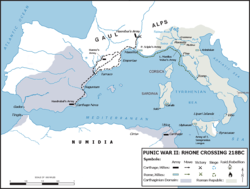Carthaginian Iberia
| Iberia | |
|---|---|

Lady of Elche
|
|
 Map of the western Mediterranean and Carthaginian control of Iberia at its greatest extent, 217 BC |
|
| Empire | Carthaginian |
The Carthaginian presence in Iberia lasted from 575 BC to 206 BC when the Carthaginians were defeated by the Roman Republic at the Battle of Ilipa in the Second Punic War.
The Phoenicians were a people from the eastern Mediterranean who were mainly traders from the cities of Tyre, Sidon, and Byblos. They colonised much of the Mediterranean and in the year 814 BC, they founded the city of Carthage. After the fall of Phoenicia to the Babylonians and Persians, Carthage became the most powerful Phoenician colony in the Mediterranean and the Carthaginians annexed many of the other Phoenician colonies around the coast of the western Mediterranean, such as Hadrumetum and Thapsus. They also annexed territory in Sicily, Africa, Sardinia and in 575 BC, they created colonies on the Iberian peninsula.
After the defeat of Carthage in the First Punic War, the Carthaginian general Hamilcar Barca crushed a mercenary revolt in Africa and trained a new army consisting of Numidians along with mercenaries and other infantry and in 236 BC, he led an expedition to Iberia where he hoped to gain a new empire for Carthage to compensate for the territories that had been lost in the recent conflicts with Rome and to serve as a base for vengeance against the Romans.
...
Wikipedia
